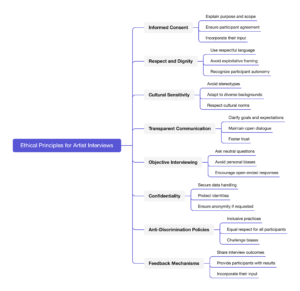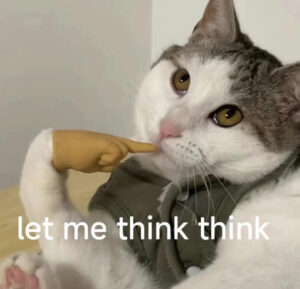Crafting Insightful Artist Interviews: A Step-by-Step Guide

Reading Time: 4 minutes1. Objective: To clarify the purpose and scope of the interview.

— Criteria for good questions: open-ended, neutral, and relevant.
2. Objective: To refine a core question and discuss it:

Summary
A practical guide for conducting artist interviews, covering essential skills, question design, and ethical practices to foster insightful and meaningful conversations.
Good questions lead to good answers – the secret to learning to talk to artists is here!
—————————————————————————
By the end of the course, you will take away:
1. an understanding of how to design meaningful and relevant interview questions.
2. develop skills in rapport building and active listening.
3. learn to deal with ethical issues, including consent and representation.
4. reflect on examples of successful and unsuccessful interviews to deepen understanding.
“Conversations with artists are not just about their art, but about their ideas, processes, and lives.”
– – Sarah Thornton, Seven Days in the Art World
Preparation Tools
– Recording device (smartphone, microphone, etc.).
– Transcription software or tool (e.g. Otter.ai).
– Platform for sharing the interview (e.g. blog post, podcast, video interview).
Let’s start! ⏰
Unit 1: Preparation (3 minutes)
1. Objective: To clarify the purpose and scope of the interview.
— Example: Do you want to know the artist’s motivation or a specific work of art?
— Background research: Check the artist’s biography, works and related comments to prepare for the questions.
2. Watch examples of good art interviews:
Unit 2: Ethical Principles (4 minutes)
1. Read:
— Informed Consent: Clearly communicate the purpose of the interview and ensure that participants agree before proceeding.
— Respect and privacy: Avoid asking personal or sensitive questions unless they are relevant to the topic and authorised.
— Transparent Communication: Inform participants of the direction of the questions prior to the interview to build trust.

Ethical Principles for Artist Interviews © 2024 by Yan Zhao is licensed under CC BY-SA 4.0
2. Checklist exercise: Participants fill out a simple consent checklist for the interview.
Unit 3: Negative Case (3 minutes)
— Example: Damien Hirst‘s interviews are often met with strong objections due to excessive focus on the price of the artwork, emphasising the need to respect the artist’s intentions.
— Discussion: How can questions that are too superficial, personal or biased undermine the quality of the interview?
Unit 4: Question Design (6 minutes)
1. mini-lecture: how to ask questions.
— Criteria for good questions: open-ended, neutral, and relevant.
Example:
— Poor question: ‘How much do you think your work is worth?’
— Good question: ‘How does your work reflect changes in contemporary society?’
You can watch the video:
2. Introduction to the theme of art:
– Identity and artistic expression
– Materials and techniques
– Environment and art
– The social impact of art
– Time and memory in art
3. Group exercise: choose one theme from the above subject terms, introduce your character background to another person and draft three questions.
Sample question:
– ‘As an artist, how do you express your personal identity through your work?’
– ‘How does your creative process relate to your choice of materials?’
Unit 5: Discuss With Each Other (4 minutes)
1. Exercise: In pairs, conduct a 2-minute interview using draft questions. The interviewer should focus on follow-up questions based on the artist’s answers.
2. Objective: To refine a core question and discuss it:
— Does the question meet the criteria of openness and depth?
— Does the person being asked feel respected and understood?
3. Discuss: How can follow-up questions enhance the dialogue?

Cat Meme © 2024 by Yan Zhao is licensed under CC BY-SA 4.0
—————————————————————————————————————————————————————————————————————————
Congratulations on completing it ✅
—————————————————————————————————————————————————————————————————————————
If you are interested in continuing after the lesson, here are some more examples:
1. art21: “Kara Walker on Storytelling”
https://art21.org/watch/extended-play/kara-walker-a-subtlety-or-the-marvelous-sugar-baby-short/
2. BBC: David Hockney art turned into immersive experience
https://www.bbc.co.uk/news/av/entertainment-arts-64056633
3.Tate: Artist Interviews
https://youtube.com/playlist?list=PL5uUen04IQNm5bUDiUDb15uYEa5WDNYtt&si=lngmvuSUcNqLifju
Besides, you can share and exchange your interview experience here:
1. Professional art community
a. ArtStation
– What: A gathering place for artists from all over the world, mainly for digital artists, but traditional art-related content is also welcome.
– Ideal for: sharing visual excerpts of interviews, audio links, or showcasing the artist’s work in conjunction with interviews.
– Interact with artists and enthusiasts through the comments section to share the creative inspiration behind the interviews.
b. DeviantArt
– Characteristics: Emphasis on creative community interaction, suitable for sharing artworks related to the interview or excerpts of interviews.
– Suitable for content: sharing graphic and text parts of the interview, such as the artist’s creative concepts or the golden words in the interview.
c. The British Art Network
– Features: Focusing on the research and discussion of British art, it can be used as a platform for academic dissemination of high-quality interviews.
– Suitable for: Publishing research results related to interviews or sharing the results of interaction between artists and the community.
2. Localised arts and cultural support networks
a. Creative Scotland
– Characteristics: Focuses on the arts and creative industries in Scotland and can share interviews through local resources.
– Suitable for: linking interviews to the local arts community to facilitate deeper communication.
b. Local Gallery Websites or Blogs
– For example, the Scottish Museum of Modern Art website and blog to share interview transcripts.
– Submit content to local gallery social media platforms to promote in conjunction with the exhibition.
Crafting Insightful Artist Interviews: A Step-by-Step Guide © 2024 by Yan Zhao is licensed under CC BY-SA 4.0
(Artist Interviews © 2024 by Yan Zhao is licensed under CC BY-SA 4.0 )


